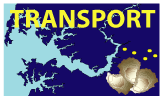 ©2020 Biological and Chemical Oceanography Data Management Office.
©2020 Biological and Chemical Oceanography Data Management Office.Funded by the U.S. National Science Foundation
Additional information can be found at the TRANSPORT website: http://northweb.hpl.umces.edu/TRANSPORT/home.htm
Project description:
This coupled field-and-modeling research project is designed to address fundamental, cutting-edge questions that will significantly enhance our understanding of physical-biological interactions in planktonic organisms and quantify how pelagic life stages influence population dynamics. Technological advances in field methodology and numerical modeling will be integrated and applied to investigate and compare how circulation patterns, larval transport, sub-population connectivity, and population dynamics of the Eastern oyster, Crassostrea virginica, respond to environmental variability and habitat alteration. This project will provide information that will significantly enhance the restoration and management of oysters.
Physical-biological interactions are an integral part of understanding fish, bivalve, and crustacean early-life history and the processes that affect inter-annual variability in their recruitment to reproducing populations. The combined modeling and field approach builds on existing state-of-the-art models, it applies a new technology that will significantly advance our ability to investigate in-situ bivalve larvae dynamics, and it will generate critical information about the early life of oysters (timing of spawning, larval behavior) that is necessary for enhancing our understanding and prediction of recruitment processes.
This research will also advance our understanding of population dynamics of organisms with a pelagic life stages by making quantitative links between larval transport and a full life-cycle model. In doing so, it will provide improved understanding of the inter-relationships between, and relative importance of, larval transport, the connectivity of different reef systems, and adult growth, mortality, and gamete production, and how these relationships are influenced by changes in physical conditions and habitat.
Although focused on the oyster, Crassostrea virginica, the ecological studies and comparisons will result in a significant enhancement in our understanding of the interactions between physical conditions and a suite of bivalve species. This program will benefit society by providing new insights and understanding that will enhance fisheries management capabilities. The numerical tools developed will have the resolution appropriate for helping to guide oyster restoration programs, locate optimal sanctuaries (i.e., marine protected areas), and inform spatial management of oyster harvest. Although the quantitative tools and information generated will directly support oyster management and restoration activities of state and federal partners in Chesapeake Bay, the findings and tools developed in this project will be applicable to many other systems where bivalves comprise an important component of commercial and recreational fisheries. A PhD graduate student will be trained in field and numerical modeling research in this coupled field-and-modeling program. In addition to gaining a solid foundation in a cutting-edge field, the student will have the opportunity to develop science communication skills and interact with management agency representatives.
Publications Produced as a Result of this Research:
Gallego, A., E.W. North and E.D. Houde. 2012. Understanding and quantifying mortality in pelagic, early life stages of marine organisms — Old challenges and new perspectives. Journal of Marine Systems 93: 1-3.
Goodwin, J. D., and E.W. North. In prep. Identifying factors that influence the swimming behavior of Crassostrea virginica larvae in Choptank River and calculating their mortality.
Goodwin, J. D., E. W. North, and C. M. Thompson. 2014. Evaluating and improving a semi-automated image analysis technique for identifying bivalve larvae. Limnology and Oceanography: Methods 12: 548-562. DOI: 10.4319/lom.2014.12.548
Goodwin, J. D., E. W. North, and V. S. Kennedy. 2016. Identification of eastern oyster Crassostrea virginica larvae using polarized light microscopy in a mesohaline region of Chesapeake Bay. Journal of Shellfish Research 35(1): 157-168.
Goodwin, J. D., E. W. North, C. M. Thompson, I. Mitchell and H.M McFadden. In press. Improving a semi-automated classification technique for bivalve larvae: automated image acquisition and measures of quality control. Limnology and Oceanography: Methods.
North, E. W., D. M. King, J. Xu, R. R. Hood, R. I. E. Newell, K. T. Paynter, M. L. Kellogg, M. K. Liddel, and D. F. Boesch. 2010. Linking optimization and ecological models in a decision support tool for oyster restoration and management. Ecological Applications 20(3): 851–866.
Spires, J. E., E. W. North, and W. Long. In prep. The influence of salinity-induced mortality on larval transport between eastern oyster (Crassostrea virginica) reefs in an oligohaline estuary: model simulations and implications for restoration. Estuaries and Coasts.
Thompson, C. M., E. W. North, V. S. Kennedy, and S. N. White. 2015. Classifying bivalve larvae using shell pigments identified by Raman spectra. Analytical and Bioanalytical Chemistry 407:3591-3604, DOI 10.1007/s00216-015-8575-8
Thompson, C.M., E.W. North, S.N. White, and S.M. Gallager. 2014. An analysis of bivalve larval shell pigments using micro-Raman spectroscopy. Journal of Raman Spectroscopy 45(5):349-358
Dissertations and Theses:
Goodwin, J. D. 2015. Integrating automated imaging and a novel identification technique to estimate mortality and factors that determine the vertical distribution of Crassostrea virginica larvae. Ph.D. Dissertation. University of Maryland College Park and the University of Maryland Center for Environmental Science.
Spires, J. E. The exchange of eastern oyster (Crassostrea virginica) larvae between subpopulations in the Chotpank and Little Choptank Rivers: model simulations, the influence of salinity, and implications for restoration. Master of Science Thesis, University of Maryland College Park and Center for Environmental Science, 79 pp.
Books and One-Time Proceedings:
Anthony, Z. 2014. Optimal microscope and camera settings for counting and identifying copepods (Acartia tonsa) using a newly developed semi-automated image analysis technology. Undergraduate Research Report. 14 pp.
Hinson, K. I., E.W. North, and C.M. Thompson. 2011. New technologies to support shellfish restoration. Research Experience for Undergraduates (REU) final report.
Mitchell, I. 2013. Updates in LTRANS v.2b. University of Maryland Center for Environmental Science, Horn Point Laboratory. Cambridge, MD. 2 pp.
North, E. W. 2010. Q&A: Elizabeth North. 10/01/2009-09/30/2010, ICES Insight, September 2010, vol. 47, p. 43-44.
Schlag, Z. R., and E. W. North. 2012. Lagrangian TRANSport model (LTRANS v.2) User’s Guide. University of Maryland Center for Environmental Science, Horn Point Laboratory. Cambridge, MD. 183 pp.

Principal Investigator: Elizabeth North
University of Maryland Center for Environmental Science (UMCES/HPL)